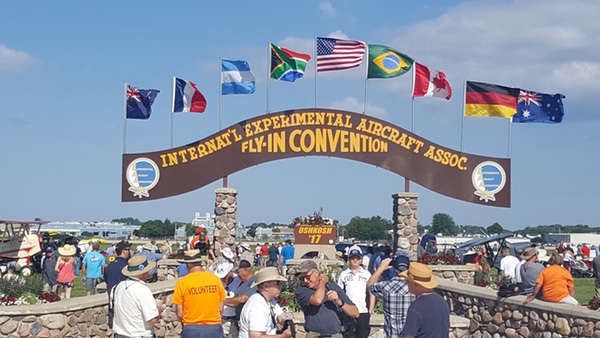I’ve died and gone to Oshkoshby Eric R. Hedman
|
| This was an especially good year for the space enthusiasts. |
There are always surprises at the EAA. Between aerobatic demonstrations, Stan Lee of Marvel Comics fame was introduced to the crowd. He was there to introduce a new superhero called Aviore. When four of the Blue Angels had taxied to the end of the runway to take off for a practice run, something went wrong and they taxied back to park. While they were taxiing out an Air Force F-35 just had to do a low pass over them with the afterburner blazing to show them who the new sheriff in town is. A small surprise was when I found a twin-engine Beechcraft Baron that had been owned by John Glenn. It had artwork on it commemorating his flight on Friendship 7.
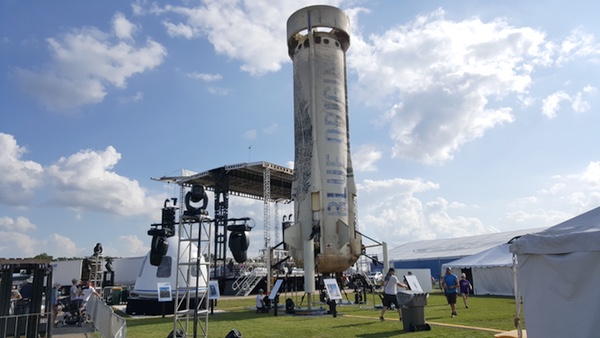 Blue Origin’s New Shepard on the grounds at AirVenture. (credit: E. Hedman) |
When I was walking into the grounds on Sunday, July 22, I noticed the New Shepard rocket standing in the distance. I had to go look. But when Jeff Bezos showed up the following Friday, unannounced, to give a tour of his capsule to the seven Apollo astronauts in town, I was not totally surprised. I didn’t think he would miss the Apollo reunion.
EAA AirVenture has something for practically everyone. It celebrates history. It showcases all facets of flight. There is a replica of the Wright Brothers original plane. You can trace the step-by-step advancements in aircraft in the museum that includes a decent-sized Moon rock in a Lucite pyramid. There is a spacesuit in the Apollo collection along with items like an outer boot worn on the Moon. The heritage of flight from the earliest days are connected together in a coherent manner through all the modern branches including spaceflight.
This was an especially good year for the space enthusiasts. NASA had a pavilion showcasing their major programs. There was a model of the ISS and a model of one possible configuration for the Deep Space Habitat. There was a booth dedicated to the proposed helicopter drone for exploring Mars. You could take a virtual reality tour of SLS and Orion.
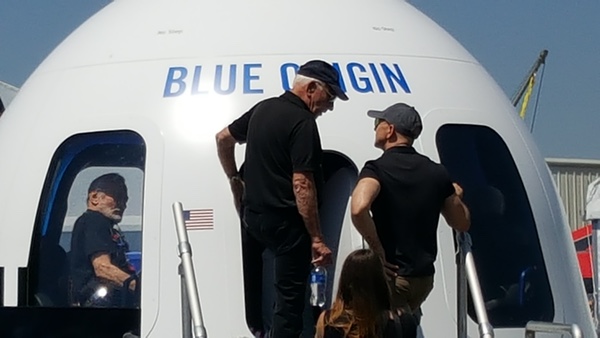 Jeff Bezos (in gray hat) gives Apollo astronauts a tour of New Shepard at AirVenture. (credit: E. Hedman) |
NASA had several interesting presentations. The first presentation I attended was, “The Journey to Mars has begun.” I wanted to attend “Hidden Figures: the Hidden Story” but it was immediately after the first and in a different location, too far away to get there in time. I was able to attend “Women In Space – Redefining Glamour”. The last presentation I attended was “NASA Fostering Commercial Space” presented by Dr. Douglas Terrier, NASA’s acting chief technologist. I will have details on these in articles to come in the next few weeks.
| It was a sight to behold when Buzz Aldrin was visible in one of the seats through a window while Gene Kranz was standing outside of the hatch. |
There were things to look at that you might at first think were not space related, but had connections to spaceflight in some way. Ford Motor Company had a tent where they were showing off their wares. You could see every car model they make, including two of the latest GT40 sports cars. They also had the self-driving Fusion. The self-driving technology is directly applicable to future planetary rovers that will need to be more autonomous in figuring out how to get from point A to point B without constant input from someone who may be millions of kilometers away.
One of the people working on the technology at Ford was there and explained where they are at in development. He said that they use radar to scan out to about 200 meters while lidar is used close in. That gives them coverage within the distance they need to make immediate decisions on steering, braking, and acceleration; all things that would be needed on an autonomous rover. He said there are three areas they still need to improve upon, including new vehicle-to-vehicle communications systems to address some of the issues of coordinating multiple vehicles in an area. This could directly apply to a time when multiple rovers, autonomous and with drivers, are working on the Moon or Mars to build up an outpost. He also said that they would have preferred a GT40 for their development work, but were turned down on that.
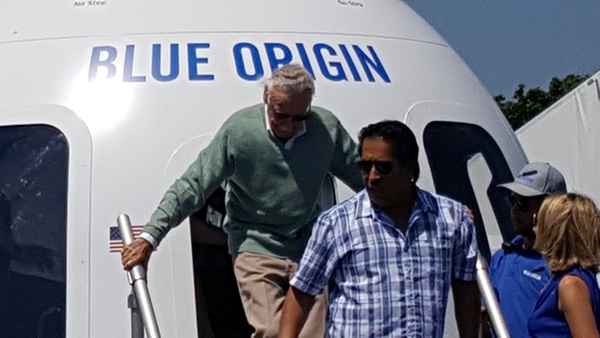 Stan Lee exits the New Shepard crew capsule model at AirVenture. (credit: E. Hedman) |
Another technology being showcased that has direct applications to space exploration is drones. There was a tent in which roughly a dozen companies were showing of their drones. Shortly after I entered, a small quadcopter drone, no bigger than five centimeters by five centimeters and maybe a centimeter thick, came to a stop roughly a foot in front of me at shoulder height. After hovering there for a few seconds, it shot forward just past my right shoulder and behind my back and dropped to about a meter above the floor and snaked at high speed through the crowd. I looked around and spotted the pilot seated in a booth with goggles on and the controls in his hands. This is the kind of technology that could directly apply to drone copters on Mars, provided the pilot was reasonably close by.
When I stopped by the Blue Origin display on Thursday the 27th, several people told me that I absolutely needed to come back the next day before noon. It was something I could not afford to miss and I needed to be one of the first thousand people in line. On Friday, I arrived at the Blue Origin display before noon where a crowd was beginning to gather. Jeff Bezos arrived shortly after and gave a tour of his rocket and capsule to the Apollo astronauts, Gene Kranz, and Stan Lee. It was a sight to behold when Buzz Aldrin was visible in one of the seats through a window while Gene Kranz was standing outside of the hatch. The first thousand people received a goodie bag that included a Blue Origin baseball cap.
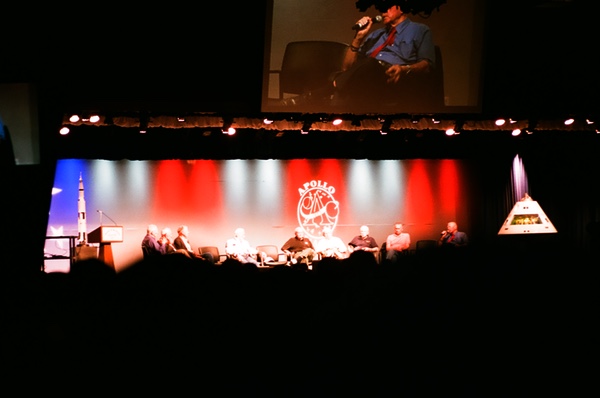 Apollo astronauts gather for a reunion on stage at EAA AirVenture. (credit: E. Hedman) |
The highlight of this year’s event was the Apollo astronaut reunion. That alone was worth the trip regardless of where you would be coming from. I’ll cover the reunion in a future article, but as a teaser, there were seven astronauts and Gene Kranz talking for two hours in a program that was hosted by David Hartman, the former host of ABC’s “Good Morning America” program. It was one of the best two-hour stretches of my life. I would have been kicking myself for years if I had missed it.
As the last weekend of July came to a close so did the 2017 Fly-In. I spent parts of four days roaming the grounds trying to get from place to place to breathe it all in. Yet I still missed plenty because there is so much to see and do. While I am now back to my more mundane daily life after my trip to Oshkosh, I can already start looking forward to my next trip. If you missed this year, you will probably not see anything like it until the first explorers of Mars come for their reunions. Even so, the EAA AirVenture needs to be on the bucket list of anyone who loves flight of any kind. I’ll see you there next time.
